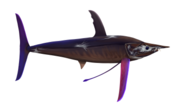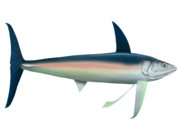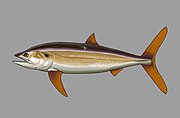Pachycormiformes
| Pachycormiformes Temporal range: Early Jurassic - Late Cretaceous,
| |
|---|---|

| |
| Skeleton of Pachycormus | |

| |
| Skeleton of Orthocormus | |
| Scientific classification | |
| Domain: | Eukaryota |
| Kingdom: | Animalia |
| Phylum: | Chordata |
| Class: | Actinopterygii |
| Infraclass: | Teleosteomorpha |
| Division: | † Aspidorhynchei
|
| Order: | †Pachycormiformes Berg 1937 |
| Family: | †Pachycormidae Woodward, 1895 |
| Type genus | |
| Pachycormus Agassiz, 1833
| |
| Genera | |
|
See text | |
| Synonyms[1] | |
| |
Pachycormiformes is an extinct order of marine
suspension-feeding
forms.
Description

Pachycormiformes are united by "a compound bone (rostrodermethmoid) forming the
suspension feeding Leedsichthys, which is estimated to have reached a maximum length of around 16 metres (52 ft).[5]
Relationships
Pachycormiformes are generally interpreted as basal members of Teleosteomorpha, the group that includes all fish more closely related to modern teleosts than to Holostei (the group containing bowfin and gars), often they have been considered to be the sister group of the Aspidorhynchiformes.[6][7]
Gallery
-
Reconstruction of Protosphyraena perniciosa
-
Life restoration of Leedsichthys
-
Life restoration of Ohmdenia
-
Life restoration of Bonnerichthys
-
Life restoration of Pachycormus
-
Life restoration of Orthocormus
Taxonomy
Taxonomy according to Cooper et al. (2022):[8]
- Euthynotus Wagner, 1860
- Haasichthys Delsate, 1999
- Notodectes Dolgopol de Saez, 1949
- Pseudoasthenocormus
- Sauropsis Agassiz, 1843
- Hypsocorminae Vetter, 1881
- Australopachycormus Kear, 2007
- Hypsocormus Wagner, 1860
- Kaykay Gouiric-Cavalli & Arratia, 2022[9]
- Orthocormus Weitzel, 1930
- Protosphyraena Leidy, 1857
- Simocormus Maxwell et al., 2020
- Asthenocorminae Cooper et al., 2022
- Germanostomus Cooper et al., 2022[8]
- Ohmdenia Hauff, 1953
- Pachycormus? Agassiz, 1833
- Saurostomus Agassiz, 1843
- Suspension-feeding clade
- Asthenocormus Woodward, 1895
- Bonnerichthys Friedman et al., 2010
- Leedsichthys Woodward, 1889
- Martillichthys Liston, 2008
- Rhinconichthys Friedman et al., 2010
Cladistics according to Friedman et al. (2010).[10]
| Pachycormiformes |
| ||||||||||||||||||||||||||||||||||||






